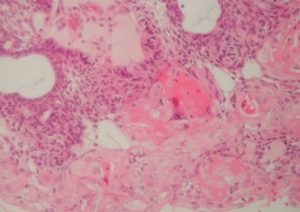Introduction
Craniopharyngiomas are a type of brain lesion that originates from embryonal remains connecting the brain with the pharynx (Rathke’s pouch). They usually appear close to the area of the pituitary gland or just above it.

Signs and symptoms
The symptoms will depend on the exact location of the lesion. However, the most frequent symptoms are: headache, nausea, vomiting, visual disorders if the optic chiasma is affected and symptoms related to hormonal disorders due to its relationship with the pituitary gland.
Diagnosis
Correct study of the lesion requires performing two types of tests:
- Anatomical: Cranial magnetic resonance imaging to define the lesion and its relationship to surrounding structures.
- Functional: hormonal testing as many lesions are in contact with the pituitary gland and cause hormonal disorders.
Treatment
The treatment of craniopharyngiomas is surgical, usually with a nasal approach using endoscopy.
This requires a multidisciplinary team for pre/intra/postoperative hormonal control as well as a neurosurgeon expert in endoscopy for performing this type of surgery.



